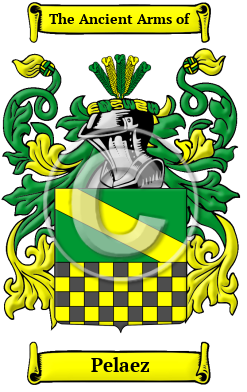-
TRIBAL AFFILIATION
Anasazi/Mayan/Mixtec
-
SURNAME HERITAGE
Spain

Pelaez History, Family Crest & Coats of Arms
From the historical and enchanting region of Spain emerged a multitude of noble families, including the distinguished Pelaez family. The earliest forms of hereditary surnames in Spain were the patronymic surnames, which are derived from the father’s given name, and metronymic surnames, which are derived from the mother’s given name. Spanish patronymic names emerged as early as the mid-9th century and the most common patronymic suffix is ez. The patronyms were derived from a variety of given names that were of many different origins.
The root name Peláez meant “son of Pelayo” and the popular variants Paez and Baez are thought to be extensions of the original name. Pelayo is the Spanish form of the Latin name Pelagius and the Greek Pelagio, meaning “the sea” or “open-sea”.
Pelagius (c. 354-418), born in Roman Britain, was a theologian known for developing Pelagianism which emphasized human choice in salvation and denied the original sin. The Pelagian heresy rejected the doctrine of original sin and predestination, insisting on free will and man’s innate capacity to do good.
Pelagius (c. 685-737) was a Hispano-Visigoth nobleman who founded the Kingdom of Asturias in 718. He is credited with initiating the Reconquista, the Christian reconquest of the Iberian Peninsula from the Moors. Pelagius of Córdoba (c. 912-926) (in Spanish San Pelayo Mártir) was a Christian boy who died as a martyr in Córdoba in southern Spain around 926 AD. Pelagius was later enshrined as a Christian martyr and canonized as “Saint Pelagius.”
Early Origins of the Pelaez family
The surname Pelaez was first found in Asturias, where the Visigothic court took refuge from the Muslim occupation of Spain. Located in the north-west of Spain, it is now an autonomous community.
Later Baeza, in the province of Jaén, Andalusia would be the home of one of the branches of this distinguished family. The Roman Catholic Diocese of Baeza (Latin Beatia) established in 715 AD was a Visigothic Catholic bishopric, suppressed under Moorish rule.


